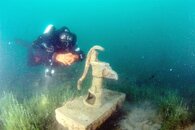This was in today's Calgary Herald. I'm not sure how long the link will last but I'm also not sure if it's OK to just cut and paste. I'll leave that up to a mod. -
Diver uncovers submerged artifacts of forgotten Alberta communities
Diver uncovers submerged artifacts of forgotten Alberta communities





